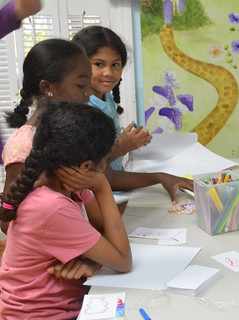Inspired by Calculus: Tuesday Math Circle Week 1
This is a quick report about our new local Math Circle. To all who asked, yes, we will produce online courses and organized materials for this content! Meanwhile, there will be these reports.
On the first meeting, Circle participants introduced themselves and started to explore infinity. Here are some purposes (whys) that drive our activities. I also suggest things to do at home – IF you feel like it, and IF it comes up. Be gentle, have fun.
The main three principles:
1 – Make math your own, to make your own math
2 – Have rich adventures
3 – Do it with friends

I will put all photos into this set on Flickr: http://www.flickr.com/photos/26208371@N06/sets/72157636116988425/
- “What do you like to do?” helps people to feel confident and secure. It’s a value affirmation: here is who I am and here is what’s important for me. For math, remembering what you like gives you a safe home base. Notice that several kids who (I am told) don’t like math used their favorite activities or objects in their work. “This can be not about math, but about you and what you like.” Applied math, in other words. At home: whenever kids mention what they like to do, or that they want to do something, or that they like their current activity, note it in a journal, a bulletin board, or a shared file. When the going gets tough, look there. Mix math with those activities.
- “Draw or make infinity” is a scavenger hunt of sorts. It also supports learner agency, but within one a math concept. So it’s a gentle step from “this is all about me” to “this is about my ideas in math.” I love the diversity of responses – the symbol of infinity, numbers 1, 2, 3… that go on, busy roads intersecting everywhere, a cylinder with a line across it, an empty card (very philosophical), trees’ cycle of life… And this activity gives us a common vocabulary, with references to personal ideas in the group. At home: keep looking for infinity everywhere: in books, in games, in the nature, in people’s cyclic behaviors, in the arts and sciences.
- Human Knots (hold hands, knot, un-knot) is, strictly speaking, a topology game, but we connected it to infinitely going loops. One of the main goals is to get up and move around, while doing some relevant math. At home: look for loops, cycles and iterations as a special example of infinity. For example, day-night cycles and the corresponding human routines: get up, have breakfast… go to sleep.
- Making fractals (self-similar pictures) took us to a particular, highly useful implementation of infinity. We will start there next time to go toward limits. In particular, I hope to explore why .99999…=1 since it’s a fundamental truth in calculus most adults don’t really get. Each decimal place is like the next level of a fractal. Fractals have a lot of applications in science, for example, understanding why trees, corals and our lungs have that branching shape (hint: think of limited volumes and great surfaces). At home: look at fractal pictures and videos online. Go on scavenger hunts for fractals in nature (ferns, feathers) and culture (designs). Draw fractal pictures.
- Watching good videos together helps kids to make friends (by sharing their appreciation), and to finish the math meeting on a high note. Look at the excited and inspired faces in the photo below: that’s what I want to see around math. Kids are likely to seek more math videos at home, since YouTube has a good “relational” search. Once they watch one vid about fractals, it offers them more – about fractals! Children also see themselves as makers (of their fractal pictures) among other makers (of more polished, but clearly home-made media). It can inspire them to the higher quality and the higher interest in math projects. At home: watch short YouTube videos about fractals, infinity, and dimensions. Invite kids to make up scenarios of fractal videos.
Kids can email me if they find fractal or infinity videos they like a lot. Here are the two we watched:
Alicia Gordon emailed this – thanks! Minecraft cows & minecraft cows & minecraft cows

Related Posts
Posted in Grow







Leave a Reply